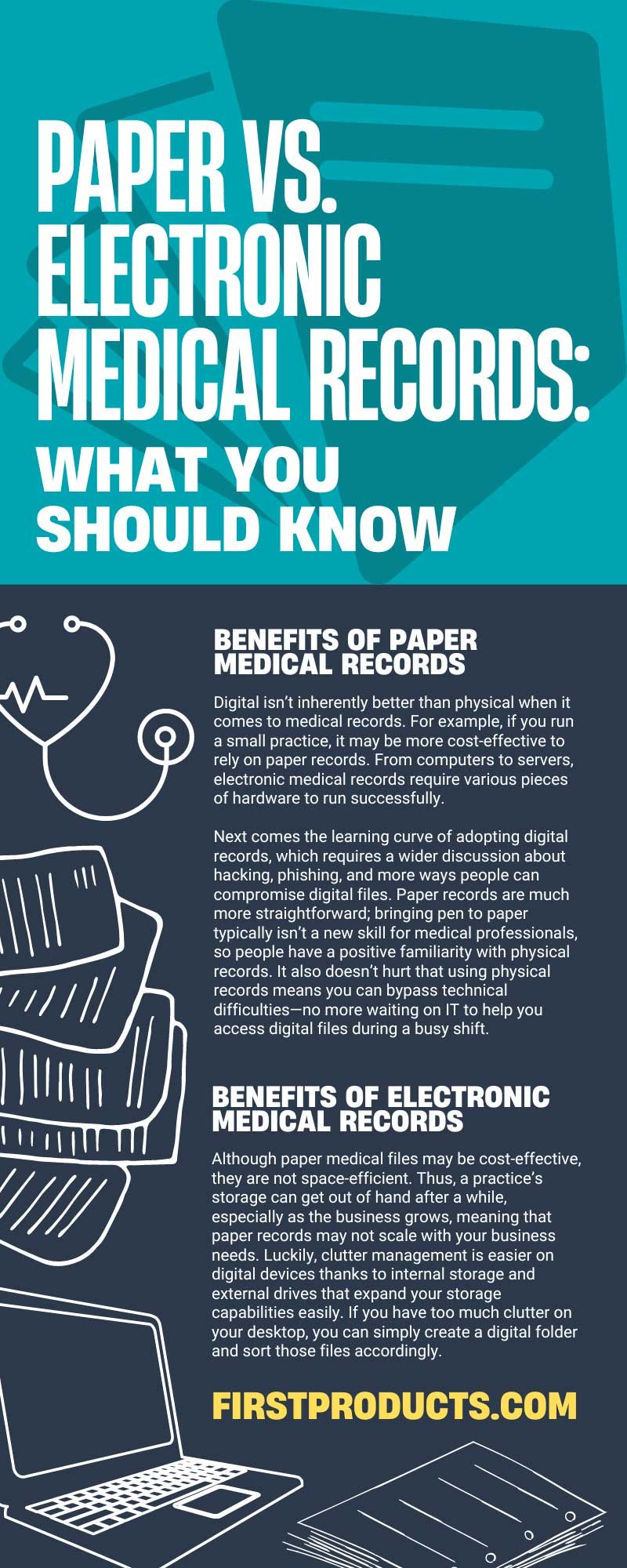By FHP on 12/2/22 10:13 AM
You may assume that paper medical records are entirely a thing of the past, but that’s not true. Physical records in binders remain alive and well in the medical community. Although paper and electronic medical records are both viable data-keeping methods, how do you choose one over the other? When comparing paper vs. electronic medical records, you should know the different aspects, ranging from the storage benefits to the training necessities and more.
Since you can use both record-keeping options, we want to help you plan the best strategy for your medical practice. After all, every practice deserves a chance to design the best system for its needs, whether that’s electronic files, physical files, or a mixture of both.
Benefits of Paper Medical Records
Let’s start with the classic—paper patient records. Digital isn’t inherently better than physical when it comes to medical records. For example, if you run a small practice, it may be more cost-effective to rely on paper records. From computers to servers, electronic medical records require various pieces of hardware to run successfully.
Next comes the learning curve of adopting digital records, which requires a wider discussion about hacking, phishing, and more ways people can compromise digital files. Paper records are much more straightforward; bringing pen to paper typically isn’t a new skill for medical professionals, so people have a positive familiarity with physical records. It also doesn’t hurt that using physical records means you can bypass technical difficulties—no more waiting on IT to help you access digital files during a busy shift.
Instead, you can easily access and sift through well-organized charts to find exactly what you’re looking for. At First Products, our medical paper chart supplies include binders, clipboards, chart racks, and other ways to organize files how you need them. Of course, this aspect means that medical professionals themselves must sort paper files to avoid creating a cluttered, inefficient system.
For instance, clearly labeling binder pages is a simple step that makes it easy to flip to the precise document you’re looking for. Binders aren’t only useful in school—the medical field uses them for data entry to this day, even while modern digital record-keeping thrives.
Although the method may seem archaic on the surface, there are surprising benefits to using physical medical records. That said, electronic files have many benefits, too, so let’s break down how they can help.
Benefits of Electronic Medical Records
Although paper medical files may be cost-effective, they are not space-efficient. Thus, a practice’s storage can get out of hand after a while, especially as the business grows, meaning that paper records may not scale with your business needs. Luckily, clutter management is easier on digital devices thanks to internal storage and external drives that expand your storage capabilities easily. If you have too much clutter on your desktop, you can simply create a digital folder and sort those files accordingly.
Plus, you can’t easily misplace or physically damage a digital file, making information easier to secure, especially when you have proper anti-virus software in place. Of course, you can mismanage an external drive and physically damage a computer, but responsible handling is all you need to prevent such situations from occurring.
Remember that, like with paper medical records, you must carefully organize your electronic records to maximize the efficiency provided by the digital format. Moreover, organizational systems and clear labels ensure you can use another benefit of digital records—readability. Not everyone has excellent handwriting, so paper records can become illegible in the wrong hands. Thanks to the clear readability of a modern tablet or computer monitor, you can avoid misreading critical information pertaining to your patients. Suffice it to say that being able to read patient records helps to provide accurate healthcare services and data entry.
Space, Mobility, and Beyond
On the surface, you may assume digital record-keeping takes up too much space because you have to fit the computers somewhere. The truth is that you can find ways to maximize space when using digital records, thanks to the various devices and storage options available. For example, you can rely on laptops or tablets to introduce digital files into your medical practice while using minimal space and optimizing mobility.
Speaking of mobility, you can use custom carts for storing and using those devices around the building. For example, at First Products, our online inventory includes mobile medical carts designed specifically for devices, including laptops, tablets, and other forms of digital record-keeping hardware. These tools allow you to take your device and create a comprehensive workstation that moves around the medical facility with you.
Another potential benefit of digital over physical documents is that someone can’t physically grab and run away with a digital file. Someone can hack in, but security software minimizes the risk of viruses infiltrating your records. Educating your employees on phishing scams will also help staff members avoid falling victim to avoidable virtual traps. That said, can’t someone misplace or steal a tablet or laptop because they’re more mobile?
A tablet is easier for a malicious party to run away with than a large computer, but you can take easy security measures to prevent such incidents. For example, having a dedicated, secure storage place for mobile medical devices provides an uncomplicated way for staff to keep track of devices. Once again, an organizational system ensures anyone can contact the right staff member if a device goes missing.
Find the Perfect Solution for Your Facility
There are many things you should consider when comparing paper and electronic medical records. As you now know, there’s no clear right or wrong between both data-keeping methods because the right steps differ depending on your facility’s needs.
If you don’t want to invest in a digital record-keeping system, you can still implement a paper record system effectively. That said, digital record-keeping clearly has substantial benefits that are worth exploring if you want a more modern, innovative way to input patient data. Luckily, if one method doesn’t feel right, you can always put together a strategy for changing your data-keeping practices. Now that you know more about digital and physical records, you don’t have to wait too long to tell whether you’re using the most efficient system for your needs.

_11wX8.5h-FINAL.png?width=721&name=FP-Logo-Horizontal-(COLOR)_11wX8.5h-FINAL.png)


comments